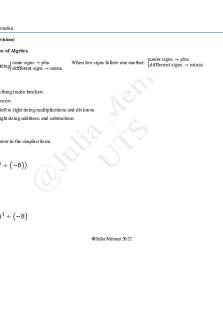Experiment 9 DLDA Shiftreg FF PDF

| Title | Experiment 9 DLDA Shiftreg FF |
|---|---|
| Author | pranay bagrecha |
| Course | Digital Logic Design And Analysis |
| Institution | University of Mumbai |
| Pages | 3 |
| File Size | 203.6 KB |
| File Type | |
| Total Downloads | 95 |
| Total Views | 133 |
Summary
DLDA experiment on shift registers...
Description
Digital Logic Design And Analysis
Second Year Computer Engineering 2018-19
EXPERIMENT 9 : SHIFT REGISTER AIM: To realize and study of Shift Registers 1) SISO (Serial in Serial out) 2) SIPO (Serial in Parallel out) 3) PIPO (Parallel in Parallel out) 4) PISO (Parallel in Serial out)
LEARNING OBJECTIVE:
• To identify the basic forms of data movement in shift register • To learn different modes data transfer COMPONENTS REQUIRED: IC 7495, LEDs, Power supply, Breadboard, PINOUT DIAGRAM FOR IC7495:
THEORY:In digital circuits, a shift register is a cascade of flip flops, sharing the same clock, in which the output of each flip-flop is connected to the "data" input of the next flip-flop in the chain, resulting in a circuit that shifts by one position the " bit array" stored in it, shifting in the data present at its input and shifting out the last bit in the array, at each transition of the clock input. More generally, a shift register may be multidimensional, such that its "data in" and stage outputs are themselves bit arrays: this is implemented simply by running several shift registers of the same bit-length in parallel. Shift registers can have both parallel and serial inputs and outputs. These are often configured as 'serial-in, parallel-out' (SIPO) or as 'parallel-in, serial-out' (PISO). There are also types that have both serial and parallel input and types with serial and parallel output. There are also 'bidirectional' shift registers which allow shifting in both directions: L→R or R→L. The serial input and last output of a shift register can also be connected to create a 'circular shift register'.
Digital Logic Design And Analysis
Second Year Computer Engineering 2018-19
1)SERIAL IN SERIAL OUT (SISO) (Right Shift) Serial i/p data 0 1 0 1 X X X X
Shift Pulses
QA
QB
QC
QD
t1 t2 t3 t4 t5 t6 t7 t8
X 0 1 0 1 X X X X
X X 0 1 0 1 X X X
X X X 0 1 0 1 X X
X X X X 0 1 0 1 X
QA
QB
QC
QD
X 0 1 0
X X 0 1
X X X 0
X X X X
1
0
1
0
2)SERIAL IN PARALLEL OUT (SIPO) Serial i/p data 0 1 0 1
Shift Pulses t1 t2 t3 t4
3)PARALLEL IN PARALLEL OUT (PIPO) Clock Input Terminal CLK2
Shift Pulses
QA
QB
QC
QD
t1
X 1
X 0
X 1
X 0
4)PARALLEL IN SERIAL OUT (PISO) Clock Input Terminal -
Shift Pulses
QA
QB
QC
QD
-
X
X
X
X
CLK2
t1
1
0
1
0
CLK2
t2
X
1
0
1
Digital Logic Design And Analysis
Second Year Computer Engineering 2018-19
0
t3
X
X
1
0
1
t4
X
X
X
1
X
t5
X
X
X
X
PROCEDURE 1)Give biasing to the IC 2)Do connections for SIPO, PIPO and note down corresponding o/p.
OBSERVATIONS I) PIPO : Parallel I/P Parallel O/P M
Clk2
A
B
C
D
QA
QB
QC
QD
Serial I / P
QA
QB
QC
QD
D I/P
QA
QB
QC
QD
1 1 II) SIPO : Serial I/P Parallel O/P a) Shift Right M
Clk1
0
b) Shift Left M
Clk2
1
Postlab Questions: 1. What is shift register ? Explain 4 bit bi-directional shift register 2. Design 4 bit Johnson counter. 3. Design 4 bit twisted ring counter....
Similar Free PDFs

Experiment 9 DLDA Shiftreg FF
- 3 Pages

Experiment 1 DLDA 2018-19
- 3 Pages

Experiment 6 DLDA 2018 19 MUX
- 3 Pages

Experiment 9
- 6 Pages

FF resum
- 8 Pages

Experiment 9 - Medina
- 7 Pages

Experiment 9 Vitamin C
- 4 Pages

Experiment 9-Natural Products
- 2 Pages

Experiment 9 lab
- 10 Pages

Experiment 9 volumetric analysis
- 4 Pages

LB17 Tortuga Verde FF
- 20 Pages

Lista RMcomresposta FF
- 9 Pages

Experiment 9 Student Report Template
- 11 Pages

Experiment 9:10 - Lab Report
- 5 Pages
Popular Institutions
- Tinajero National High School - Annex
- Politeknik Caltex Riau
- Yokohama City University
- SGT University
- University of Al-Qadisiyah
- Divine Word College of Vigan
- Techniek College Rotterdam
- Universidade de Santiago
- Universiti Teknologi MARA Cawangan Johor Kampus Pasir Gudang
- Poltekkes Kemenkes Yogyakarta
- Baguio City National High School
- Colegio san marcos
- preparatoria uno
- Centro de Bachillerato Tecnológico Industrial y de Servicios No. 107
- Dalian Maritime University
- Quang Trung Secondary School
- Colegio Tecnológico en Informática
- Corporación Regional de Educación Superior
- Grupo CEDVA
- Dar Al Uloom University
- Centro de Estudios Preuniversitarios de la Universidad Nacional de Ingeniería
- 上智大学
- Aakash International School, Nuna Majara
- San Felipe Neri Catholic School
- Kang Chiao International School - New Taipei City
- Misamis Occidental National High School
- Institución Educativa Escuela Normal Juan Ladrilleros
- Kolehiyo ng Pantukan
- Batanes State College
- Instituto Continental
- Sekolah Menengah Kejuruan Kesehatan Kaltara (Tarakan)
- Colegio de La Inmaculada Concepcion - Cebu

